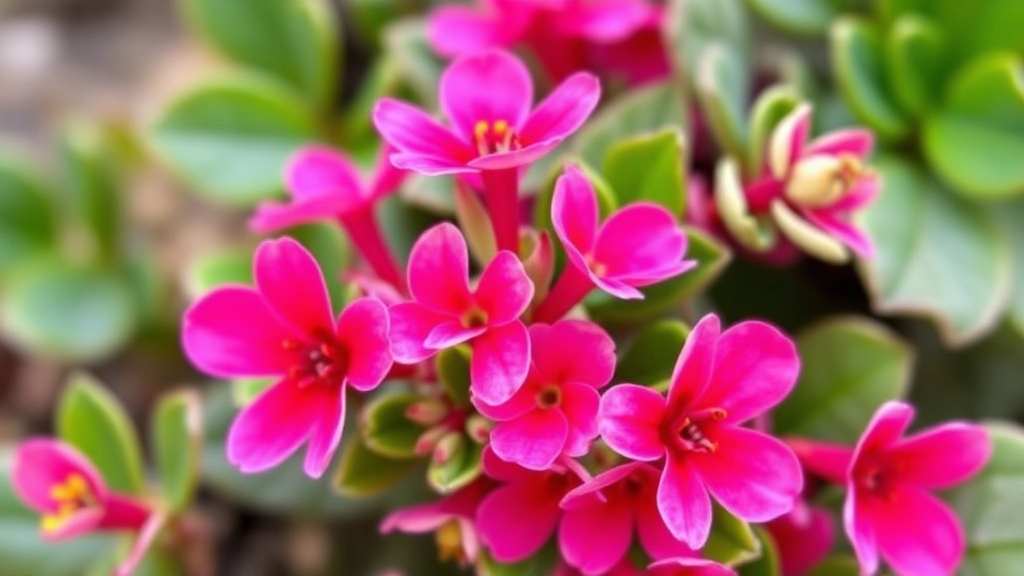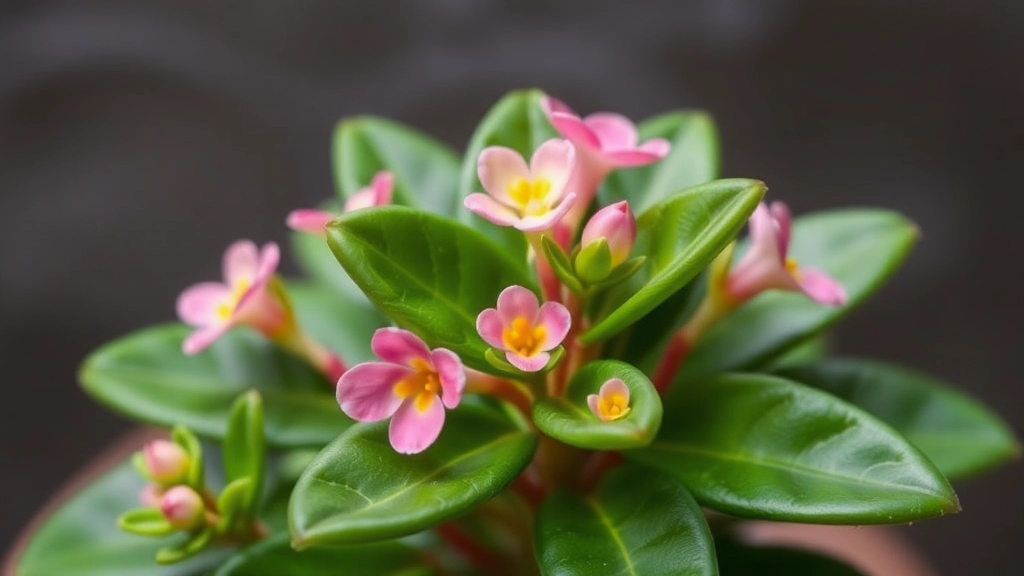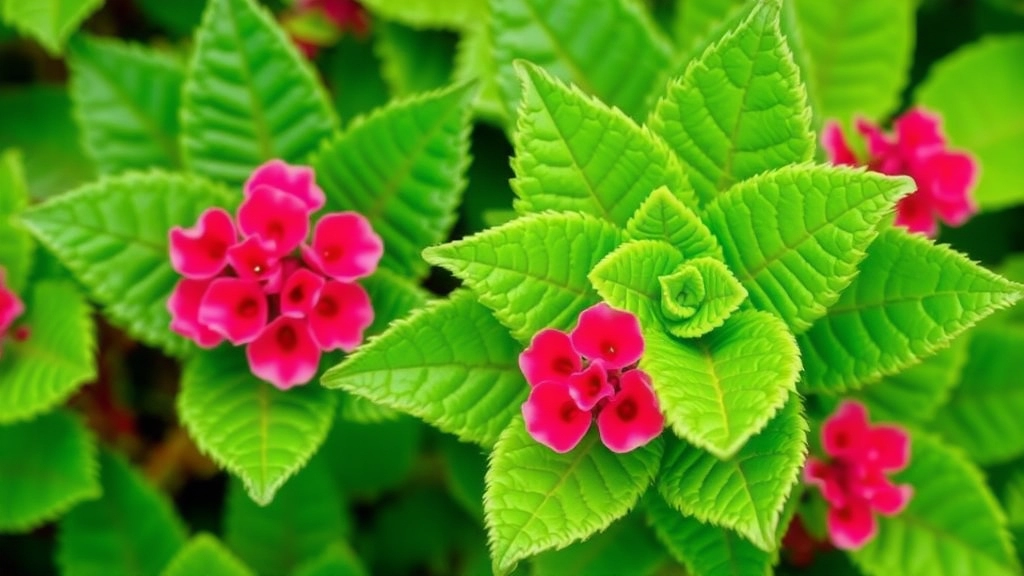Curious about Kalanchoe Leaf Benefits?
You’re in the right place. From its impressive wound healing properties to its role in combating inflammation, Kalanchoe leaves are a powerhouse of natural remedies. Many people turn to these leaves for pain relief, treating conditions like asthma, and even for their potential anti-cancer properties. It’s not just about health benefits; Kalanchoe leaves also shine in skin care and cosmetic uses.
How to Use Kalanchoe Leaves Effectively
But how do you use Kalanchoe leaves effectively? Whether you’re making a soothing tea, applying it topically, or using it for respiratory and digestive support, there’s a method for everyone. Dive in to discover practical advice and tips on harnessing the full potential of Kalanchoe leaves for your health and well-being.
Health Benefits of Kalanchoe Leaves
Have you ever wondered how a simple plant can offer a wealth of health benefits? Kalanchoe leaves, often overlooked, are packed with nutrients and therapeutic properties that can enhance your well-being.
Kalanchoe is not just a pretty houseplant; it boasts a range of health benefits that can support various aspects of your health. Here are some key advantages:
- Rich in Nutrients: Kalanchoe leaves are loaded with vitamins and minerals, including vitamin C, calcium, and magnesium.
- Antioxidant Properties: These leaves contain antioxidants that help combat oxidative stress in the body.
- Anti-Inflammatory Effects: Kalanchoe is known for its ability to reduce inflammation, making it beneficial for various health conditions.
Incorporating Kalanchoe into your routine can be a game changer for your overall health. For more information on how to use Kalanchoe Pinnata for health benefits or to learn about the top health benefits of Kalanchoe Mother of Thousands, visit our detailed guides.
Anti-Inflammatory Properties and Uses

Have you ever felt that nagging ache after a long day? Or maybe you’ve dealt with swelling that just won’t quit? You’re not alone. Many of us are on the lookout for natural remedies to ease inflammation and pain. Enter Kalanchoe leaves, a powerhouse in the world of herbal healing.
What Makes Kalanchoe Anti-Inflammatory?
Kalanchoe is loaded with compounds that fight inflammation. These include flavonoids and phenolic acids, which have been shown to reduce swelling and discomfort.
How to Use Kalanchoe for Inflammation
Here’s how you can tap into Kalanchoe’s anti-inflammatory magic:
- Topical Application: Crush fresh Kalanchoe leaves and apply them directly to swollen areas.
- Tea: Brew Kalanchoe leaves in hot water for a soothing drink that helps calm internal inflammation.
- Pastes: Mix Kalanchoe with a bit of honey to create a paste for skin irritations.
Real-Life Examples
I remember a friend who had chronic joint pain. She started using Kalanchoe tea daily, and within a few weeks, she noticed a significant reduction in her discomfort. It’s amazing how nature can lend a hand, isn’t it?
Why It Matters
Using Kalanchoe can be a game-changer for those looking for natural ways to manage inflammation without relying on over-the-counter meds.
Wound Healing Applications of Kalanchoe
Have you ever wondered how to speed up the healing of cuts and scrapes?
Kalanchoe leaves are celebrated for their remarkable wound healing properties.
These succulent leaves are not just beautiful; they possess natural compounds that can aid in the recovery process.
Key Benefits of Kalanchoe for Wound Healing:
- Antimicrobial Properties: Kalanchoe contains compounds that help prevent infection, a crucial factor in wound care.
- Anti-Inflammatory Effects: The leaves can reduce swelling and redness around wounds, promoting a more comfortable healing environment.
- Stimulates Cell Regeneration: Kalanchoe encourages the growth of new skin cells, which can lead to faster recovery.
- Rich in Nutrients: Loaded with vitamins and minerals, Kalanchoe nourishes the skin and supports overall health.
How to Use Kalanchoe for Wound Healing:
- Fresh Leaves: Simply crush fresh Kalanchoe leaves to extract the juice and apply it directly to the wound.
- Pastes: Blend the leaves with a little water to create a paste and apply it as a dressing.
- Compress: Soak a cloth in Kalanchoe juice and place it over the wound for a soothing effect.
Real-Life Example
I once had a minor kitchen accident that left me with a nasty cut.
Using Kalanchoe from my garden, I applied the freshly crushed leaves directly to the wound.
The healing was noticeably quicker, and I experienced minimal discomfort.
Incorporating Kalanchoe into your first aid routine can make a significant difference. For more information on the benefits of Kalanchoe, check out our guide on Kalanchoe Pinnata cream benefits and learn about Kalanchoe Pinnata tea benefits.
Kalanchoe for Digestive and Respiratory Health

Many individuals struggle with digestive issues and respiratory ailments, seeking natural remedies that offer relief without the side effects of pharmaceuticals.
Kalanchoe has emerged as a promising option for addressing these concerns.
Digestive Health Benefits
Kalanchoe leaves are known to support digestive health in several ways:
- Soothing Irritation: The anti-inflammatory properties of Kalanchoe can help soothe the digestive tract, potentially alleviating discomfort from conditions like gastritis or acid reflux.
- Promoting Gut Health: Rich in antioxidants, Kalanchoe may promote a healthy gut environment by reducing oxidative stress.
- Digestive Aid: Some users report that Kalanchoe helps in easing bloating and improving overall digestion.
Respiratory Health Benefits
When it comes to respiratory health, Kalanchoe’s benefits are equally impressive:
- Expectorant Properties: Kalanchoe may act as a natural expectorant, helping to clear mucus from the airways, making breathing easier.
- Anti-Inflammatory Effects: By reducing inflammation in the respiratory tract, Kalanchoe can provide relief from conditions like asthma or bronchitis.
- Immune Boosting: The immune-supportive properties of Kalanchoe can further protect against respiratory infections.
Incorporating Kalanchoe into your routine can be a simple yet effective way to support your digestive and respiratory health.
Immune System Support with Kalanchoe
Are you looking for natural ways to strengthen your immune system?
Kalanchoe leaves may just be the answer you’ve been searching for.
Packed with antioxidants, vitamins, and minerals, Kalanchoe has been traditionally used to bolster immune function.
Key Immune-Boosting Components
- Vitamins: Rich in Vitamin C, Kalanchoe helps enhance the production of white blood cells, essential for fighting infections.
- Antioxidants: These compounds combat oxidative stress, reducing inflammation and supporting overall health.
- Flavonoids: Known for their antiviral properties, flavonoids found in Kalanchoe can help fend off common illnesses.
How Kalanchoe Supports Immunity
- Enhances White Blood Cell Activity: This is crucial for identifying and eliminating pathogens.
- Reduces Inflammation: Lower inflammation levels can lead to a more efficient immune response.
- Boosts Overall Health: A well-functioning immune system is vital for preventing illness and maintaining balance in the body.
Practical Applications
- Tea: Brew Kalanchoe leaves in hot water for a soothing drink that supports immunity.
- Juicing: Add fresh Kalanchoe leaves to your smoothies for a nutrient boost.
- Topical Applications: Use the juice on minor cuts and scrapes to harness its healing properties.
Real-Life Example
I once had a friend who struggled with frequent colds. After incorporating Kalanchoe tea into her routine, she noticed a significant reduction in illness frequency.
While individual results may vary, Kalanchoe’s immune-boosting properties are certainly worth exploring. For more information on the health benefits of Kalanchoe, check out our guide on the miracle leaf. Additionally, if you’re interested in growing your own, our complete guide to growing Kalanchoe can be very helpful.
Natural Pain Relief: Headaches, Back Pain, and More

Ever found yourself struggling with a nagging headache or persistent back pain?
You’re not alone. Many of us grapple with these common discomforts daily.
That’s where Kalanchoe comes into play.
This incredible plant isn’t just a pretty face; it’s packed with natural pain-relieving properties that can help ease those pesky aches.
How Kalanchoe Works for Pain Relief
Kalanchoe leaves contain compounds that have been shown to reduce inflammation and alleviate pain.
Here’s how it can help:
- Headaches: Applying Kalanchoe juice to your temples may provide relief from tension headaches.
- Back Pain: A poultice made from Kalanchoe leaves can be applied directly to sore spots for soothing relief.
- Joint Pain: Regular use of Kalanchoe can help manage pain associated with arthritis.
Easy Ways to Use Kalanchoe for Pain Relief
- Juicing: Blend fresh leaves and apply the juice to affected areas.
- Poultice: Crush the leaves, mix with a bit of water, and place on sore muscles or joints.
- Tea: Steep Kalanchoe leaves in hot water for a soothing drink that may help with internal pain.
A Personal Touch
I remember a time when I had a relentless backache after a long week of work.
I decided to give Kalanchoe a shot.
I made a poultice and applied it to my lower back.
Within a short while, I felt a noticeable difference.
It’s amazing how nature can provide such effective relief!
Kalanchoe’s Role in Combating Cancer
As we explore the multifaceted benefits of Kalanchoe, one area that garners significant interest is its potential role in combating cancer. Many individuals are increasingly concerned about cancer prevention and treatment options, seeking natural alternatives alongside conventional therapies.
Kalanchoe has been studied for its anticancer properties, showing promise in various research settings. Here are some key aspects to consider:
- Antioxidant Richness: Kalanchoe leaves contain antioxidants that help neutralise free radicals, which can damage cells and lead to cancer development.
- Apoptosis Induction: Some studies suggest that compounds within Kalanchoe may promote apoptosis, the process of programmed cell death, which is crucial in eliminating cancer cells.
- Anti-Proliferative Effects: Research indicates that Kalanchoe extracts can inhibit the proliferation of certain cancer cell lines, potentially slowing tumour growth.
- Immune Modulation: By enhancing immune function, Kalanchoe may support the body’s natural defence mechanisms against cancer.
- Synergistic Effects: When used alongside conventional treatments, Kalanchoe may enhance the effectiveness of chemotherapy drugs, reducing side effects while improving outcomes.
While these findings are promising, it’s essential to approach Kalanchoe as a complementary strategy rather than a standalone treatment. Always consult with healthcare professionals before integrating any new remedy into your health regime. For more information on the health benefits of Kalanchoe Pinnata, you can read our detailed guide. Additionally, if you’re interested in growing this plant yourself, check out our comprehensive care guide for Kalanchoe Mother of Thousands.
Skin Health and Cosmetic Uses of Kalanchoe

Have you ever wondered how to achieve that radiant glow without splurging on pricey skincare products?
Kalanchoe leaves might just be your new best friend.
These succulent leaves are packed with nutrients that can work wonders for your skin.
Why Kalanchoe?
- Moisturising Properties: Kalanchoe is known for its ability to hydrate the skin, making it a fantastic natural moisturiser.
- Anti-Aging Benefits: Packed with antioxidants, Kalanchoe helps combat free radicals, which can lead to premature aging.
- Healing Qualities: If you’ve got cuts or blemishes, Kalanchoe can speed up the healing process thanks to its anti-inflammatory properties.
How to Use Kalanchoe for Your Skin
- Direct Application:
- Simply pluck a leaf, crush it, and apply the juice directly to your skin.
- Leave it on for about 30 minutes before rinsing off.
- Face Masks:
- Blend Kalanchoe leaves with honey or yogurt for a nourishing face mask.
- Apply it to your face and let it sit for 15-20 minutes before rinsing.
- Soothing Gel:
- Mix Kalanchoe juice with aloe vera for a soothing gel that’s perfect for sunburns or irritated skin.
Real-Life Example
I remember a friend of mine who struggled with acne scars.
She started using Kalanchoe juice daily, and within weeks, her skin looked noticeably clearer.
It’s a simple, natural approach that can yield impressive results.
How to Prepare and Use Kalanchoe for Maximum Benefits
When considering the incredible health benefits of Kalanchoe, you might wonder how to effectively prepare and use this versatile plant to harness its full potential.
Preparing Kalanchoe
Fresh Leaves:
- Start by selecting healthy, vibrant Kalanchoe leaves.
- Wash them thoroughly to remove any dirt or pesticides.
- Pat them dry with a clean cloth.
Juicing:
- Chop the leaves into smaller pieces.
- Use a juicer to extract the juice.
- This concentrated form is great for quick consumption.
Infusions:
FAQs on Kalanchoe Leaf Benefits
What are the primary benefits of Kalanchoe leaves?
Kalanchoe leaves offer a variety of benefits including anti-inflammatory properties, digestive and respiratory health support, natural pain relief, and skin health improvements.
How does Kalanchoe help with inflammation?
Kalanchoe is rich in compounds like flavonoids and phenolic acids that fight inflammation, helping to reduce swelling and discomfort.
Can Kalanchoe be used for digestive health?
Yes, Kalanchoe leaves can soothe irritation in the digestive tract, promote gut health by reducing oxidative stress, and aid in easing bloating and improving digestion.
How can Kalanchoe improve respiratory health?
Kalanchoe may act as a natural expectorant, clear mucus from the airways, reduce inflammation in the respiratory tract, and boost the immune system to protect against infections.
Is Kalanchoe effective for pain relief?
Yes, Kalanchoe leaves contain compounds that reduce inflammation and alleviate pain, making them effective for headaches, back pain, and joint pain.
How can I use Kalanchoe for skin health?
Kalanchoe can be used as a moisturizer, anti-aging agent, and healing remedy for cuts and blemishes. You can apply the juice directly, use it in face masks, or mix it with aloe vera for a soothing gel.
Are there any real-life examples of Kalanchoe’s effectiveness?
Many people have found relief from various ailments using Kalanchoe. For instance, a friend with chronic joint pain noticed significant improvement after using Kalanchoe tea, and another friend saw clearer skin after using Kalanchoe juice for acne scars.
What are some easy ways to incorporate Kalanchoe into my routine?
You can use Kalanchoe leaves topically, make tea, create pastes, or blend the leaves for juice. These methods can be tailored to address specific health concerns.
Is Kalanchoe safe to use daily?
While Kalanchoe is generally considered safe for most people, it’s always best to consult with a healthcare provider before incorporating any new herbal remedy into your daily routine, especially if you have underlying health conditions or are taking other medications.
